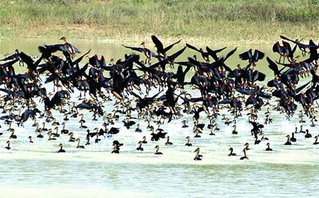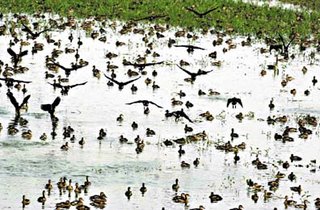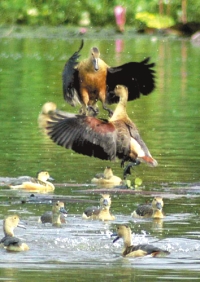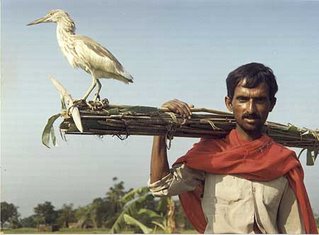
Mirpur Ceramics lake, Dhaka

Mirpur zoo lake, dhaka

Netrokona haor

Marsh land



Hakaluki Haor, Sylhet


Peelkhana lake, poachers on right


Winter Guest birds from Himalayas and far away places like Siberia move to relatively warm swampy lands in Bangladesh to escape the freezing cold, and feed on snails and tiny fishes, which are abundant during this part of the year in the rice crops in haors, baors and the swamps in the coastal areas. Birds start arriving from early November and stay till March-April.
An estimated 500,000 birds, about 150 species mainly ducks travel to Bangladesh each winter. The wetland environment, some of the famous species that visit Hakaluki include the great crested grebe, widgeon, egret, large egret, heron, night heron and snipe.
The wetland hosts a tenth of all migratory birds that arrive in Bangladesh every winter. Hakaluki Haor (water body), the biggest lake in the country is spread over Sylhet and Moulvibazar districts, which covers 45000 acres of land. [map & images of Hakaluki Haor]
The arrivals of the flocks provide winter entertainment for tens of thousands of residents who travel to suburban areas to watch the birds. Bangladesh Bird Watchers' Society and Natural Conservation Committee organize bird watching festival each year at Jahangirnagar and Mirpur Ceramic Lake. Bird lovers feed them and photographers come in groups to take pictures. The country has its own 400 species of birds, the number falling rapidly as their habitat comes under attack from urban and industrial encroachment. The number of birds is also decreasing as hatcheries, duck farms and other commercial activities thrive in the wetland. Besides, organized gangs of poachers hunt birds after mid-January when the winter chill and fog subsides.
[link to The World Conservation Union, IUCN]
An estimated 500,000 birds, about 150 species mainly ducks travel to Bangladesh each winter. The wetland environment, some of the famous species that visit Hakaluki include the great crested grebe, widgeon, egret, large egret, heron, night heron and snipe.
The wetland hosts a tenth of all migratory birds that arrive in Bangladesh every winter. Hakaluki Haor (water body), the biggest lake in the country is spread over Sylhet and Moulvibazar districts, which covers 45000 acres of land. [map & images of Hakaluki Haor]
The arrivals of the flocks provide winter entertainment for tens of thousands of residents who travel to suburban areas to watch the birds. Bangladesh Bird Watchers' Society and Natural Conservation Committee organize bird watching festival each year at Jahangirnagar and Mirpur Ceramic Lake. Bird lovers feed them and photographers come in groups to take pictures. The country has its own 400 species of birds, the number falling rapidly as their habitat comes under attack from urban and industrial encroachment. The number of birds is also decreasing as hatcheries, duck farms and other commercial activities thrive in the wetland. Besides, organized gangs of poachers hunt birds after mid-January when the winter chill and fog subsides.
[link to The World Conservation Union, IUCN]



No comments:
Post a Comment